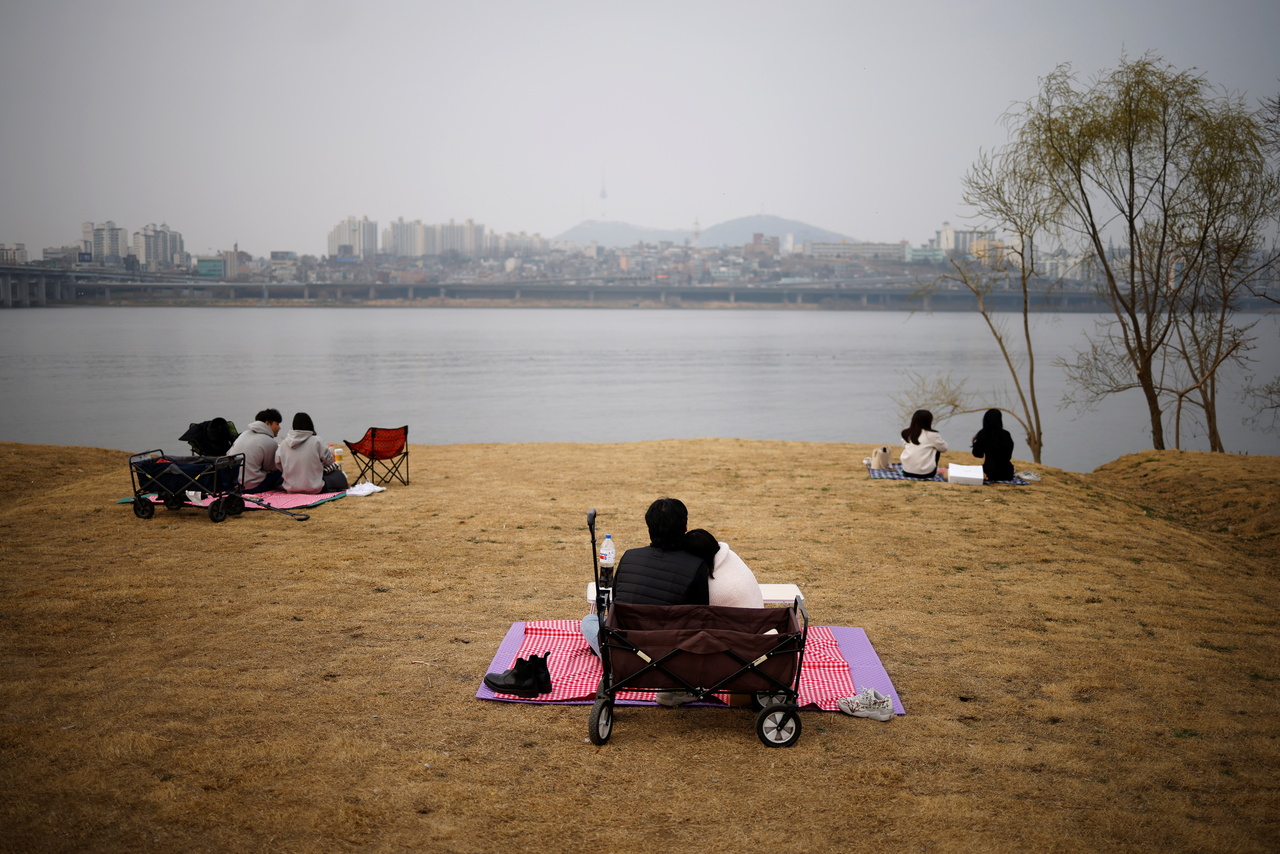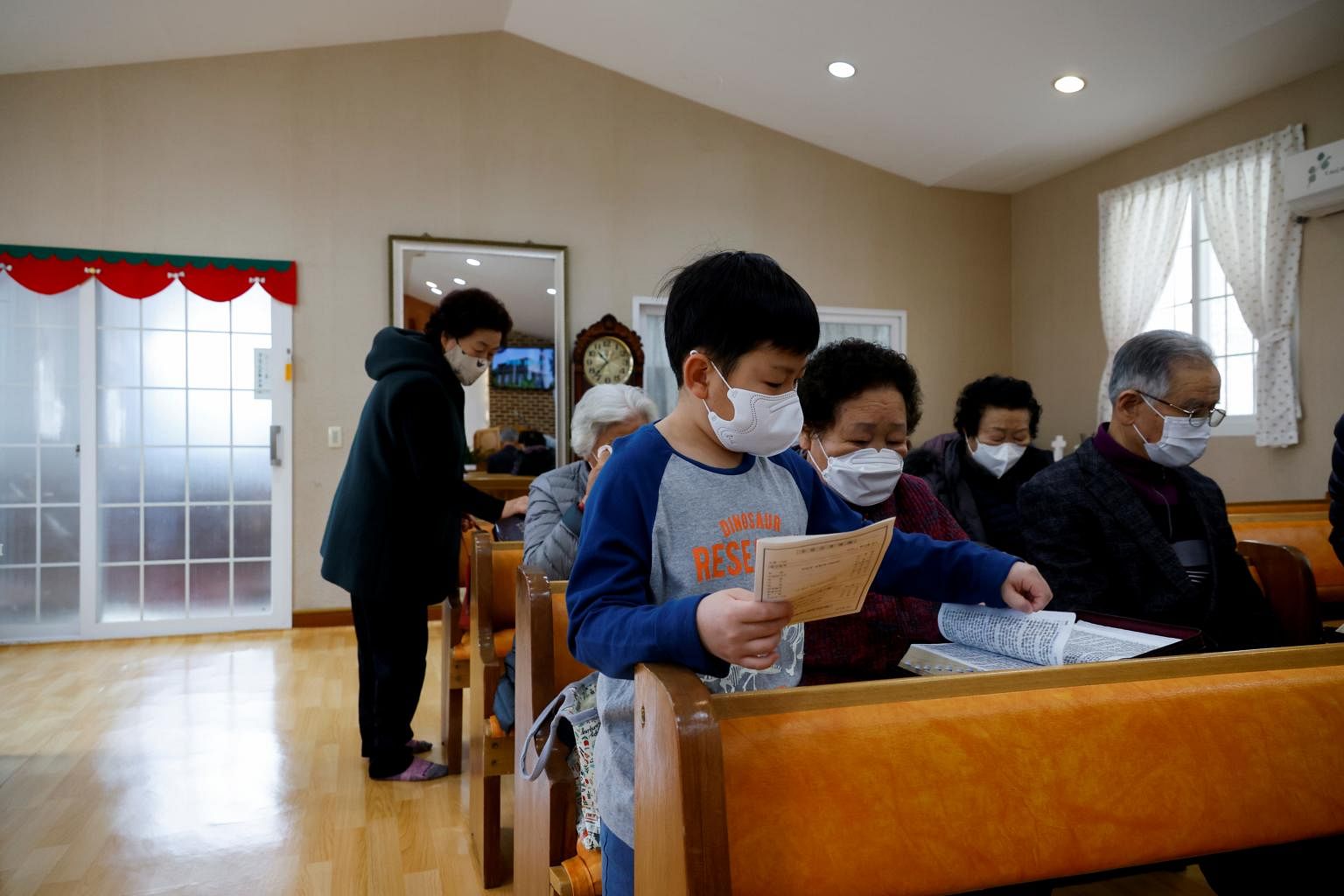South Korea crosses a population rubicon in warning to the world
Sign up now: Get insights on Asia's fast-moving developments

Last year, South Korea country registered more deaths than births for the first time in recent history.
PHOTO: REUTERS
Follow topic:
SEOUL (BLOOMBERG) - They are called the Sampo Generation: South Koreans in their 20s and 30s who have given up (po) three (sam) of life's conventional rites of passage - dating, marrying, and having children. They have made these choices because of economic constraints and in the process have worsened Korea's demographic imbalances.
Last year, when the country registered more deaths than births for the first time in recent history, then Vice-Finance Minister Kim Yong-beom pronounced the milestone a "death cross".
I Live Alone is one of Korea's most popular reality-TV shows. It follows the single lives of movie actors and K-pop singers engaging in mundane activities such as feeding their pets or eating ramen noodles in the middle of the night - all alone. People living alone already make up almost 40 per cent of the population. Honbap (a solo meal) has worked its way into everyday language; there is even a lunchbox brand called Honbap Day.
The typical age of a new mother in South Korea is 32, according to the National Statistical Office. The number of births per woman sank to a record low of 0.84 last year, the lowest rate in the world; in Seoul, the rate is 0.64. The United Nations estimates that by 2050, Korea's share of elderly people will become the largest of any country.
This demographic squeeze has slowed one of the world's most advanced economies. While Korea's gross domestic product growth last year, -1 per cent, was less bad than many countries' thanks to the nation's effective containment of the coronavirus, its average over the past 10 years -2.5 per cent - was well down from the average of more than 8 per cent from 1980 to 2000, when its workforce was younger.
Those heady times would be unrecognisable to Koreans such as Mr Yang U-jin, 25, and Ms Kim Yoon-jeong, 30.
After Mr Yang's application to, as he puts it, "every company that has to do with electronics" in and around Seoul brought little success, he moved out of the capital and back to his hometown near the southern port city of Busan, hoping for better luck there.
In Ms Kim's case, she has chosen to not have children since getting married in 2016. She says the rising costs of owning a home and raising a family make it difficult to consider having kids.
"It's impossible for a couple not to both be working," she says. "It's like the whole Korean society is pressuring young people not to have kids."
Korea's predicament is extreme but not unique. Globally, one in six people will be over age 65 by 2050, compared with one in 11 last year, according to projections by the UN's Department of Economic and Social Affairs.
Ageing is more acute in the developed world - one in four people in Canada, Europe, and the United States may be 65 or over by then, while one in six could be that old in Latin America and the Caribbean. The share of people 65 or older in southern Asia and northern Africa may also double to one in eight and one in nine, respectively.
"The problem of declining population is no longer a future challenge; it is a current reality in many economies," says Ms Sonal Varma, chief economist for India and Asia (except Japan) at Nomura Holdings in Singapore.
"While efforts are being made to boost the fertility rate, countries also need to simultaneously prepare to deal with the challenges posed by falling birthrates."
South Korea has been trying to do something about its falling fertility rate for decades. Like many other governments around the world, Seoul has been providing tens of billions of dollars in incentives, ranging from free nurseries to subsidised pay during child-care leave. It even arranged group blind dates for public servants in the hope it would lead to more marriages. None of it has really worked.
Now the government has decided to change tack, shifting the policy focus away from reversing population decline and toward finding a way to live with it.
A new two-track approach still seeks to encourage more births to ensure a future workforce that is sizeable enough to sustain its pension system, but there is increased attention on encouraging women and seniors to stay in the labour force or open new businesses.
The government has proposed easing strict immigration regulations to bring in more foreign workers, including engineers needed to keep companies such as Samsung Electronics feeding the world's voracious demand for computer chips.
In January, a pan-government task force on population policy identified 13 key issues to tackle this year - from addressing the greying manufacturing workforce to helping rural cities where populations are in decline.
"We've tried to raise the fertility rate in various ways, but it hasn't been easy, and we now have no choice but to accept what's coming and deal with it," says Ms Na Yoon-jung, a Finance Ministry official overseeing population policy.
"Ageing is a global issue, but it's happening at a tremendous pace in our country. The shrinking working population weakens our foundation for growth and increases burdens on young people."
It is not just the size of the labour force that is at stake.
Across Korea, institutions once functioned on the assumption that the nation's population would grow steadily. Now they are left grappling with demographic change. Almost half of the country's cities are at risk of drastic depopulation within 30 years, according to the Korea Employment Information Service, while some universities are already facing a stark drop-off in enrolments.

Globally, 1 in 6 people will be over age 65 by 2050, compared with 1 in 11 last year.
PHOTO: AFP
In a country locked in an armed standoff with North Korea, the population shifts are especially pertinent for the military.
According to the World Bank, North Korea's fertility rate per woman was 1.9 in 2019, while South Korea's was 0.9.
South Korea has one of the world's largest armies, but the number of conscripts has been declining for almost a decade.
These days perhaps the biggest threat to South Korea's 640,000-strong force stands not across the border but within its own boundaries: Troop numbers are expected to shrink by a third in less than two decades as the population ages.
Korea is throwing its technological might at the problem, developing unmanned vehicles that can transport ammunition or wounded soldiers and even wage combat on their own, along with robots programmed to detect mines and underground tunnels. At sea, tests with unmanned mine-hunting vessels are under way.
Hanwha Defence, an arms manufacturer, figures that robots could cut by as much as 60 per cent the number of personnel required for dangerous operations.
"It makes more sense to have a robot killed than a human," says Mr Jeon Young-jin, chief robot developer at Hanwha. "The life of each individual soldier is now more precious than ever."
The steps Korea takes to tackle its demographic dilemma will be closely watched by nations on track to encounter their own death crosses. According to the UN, deaths could outnumber births in Russia as early as this year. China's population is expected to peak in less than 10 years, while in India, the most populous nation after China, that could happen by 2060.
Japan's well-known ageing problem seems modest compared with Korea's.
Japan had already become one of the richest economies in the world by the time its demographic clock began ticking, and its major-economy status and vast domestic savings pool have allowed the government to amass huge debt in a bid to keep living standards high even as economic growth slowed.
South Korea's challenges and how it copes with them may prove more relevant precedents than Japan's for countries such as China and Thailand, which also risk getting old before they are rich.
Even if it makes progress in getting more women, elderly people, and foreign workers into the workforce, South Korea may still fall short of filling the gaping holes in productivity, labour input, and the tax base, all caused by a shrinking and greying population.
Capital Economics, a London-based consulting firm, says that just to maintain the size of the current labour force, Korea would need to see the number of immigrants increase as a share of the working-age population from the current 3 per cent to 30 per cent by 2045 - a near-impossible task that would require an overhaul of immigration laws, corporate behaviour, and social norms.
That is why technology, not an influx of immigrants, may be the answer.
Self-driving vehicles that rely on high-speed wireless networks, logic chips used to operate artificial intelligence, and automated farms utilising Internet-of-things devices are all part of the government's technological agenda.
Regularly ranked as one of the most innovative countries in the world, Korea is better placed than most to make these ideas a reality.
"With a shrinking population, productivity gains are crucial in order to maintain economic growth rates," says Mr Sung Won Sohn, an economist at Loyola Marymount University in Los Angeles. "This is an opportunity for Korea to offset the negative effects of the declining population."
That will come too late for many Koreans.
On the cusp of retirement at 59, Mr Kim Jin-hyung says he is willing to accept lower pay if he can find a new job after his decades-long career at a local bank wraps up. As it stands, he is shelving his dreams of travelling around the world and playing golf because he needs to pay for rising property taxes and does not want any financial difficulties to delay his daughters getting married someday.
"I had always thought I was well prepared for retirement," Mr Kim says. "Now, unless you're a public servant hired by the government, life is too uncertain - both for people my age and my kids' age."

